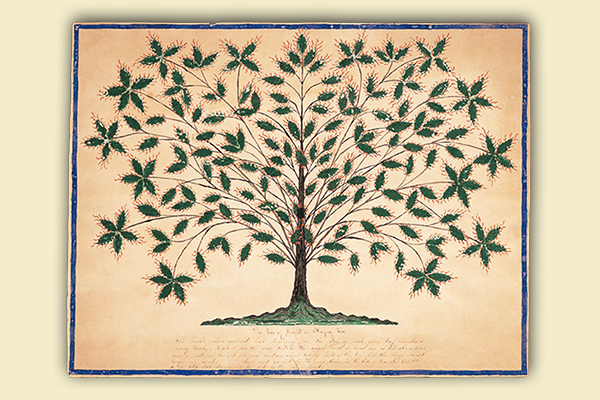“ON EARTH AS it is in heaven,” wasn’t simply a prayer for the Shakers, a small Protestant sect that practiced communal living and peaked in the mid-19th century: It was the bedrock of their lives. In the mid-1800s, Shaker Sarah Bates depicted this collision of heaven with earth in “Wings of Holy Wisdom, Wings of the Heavenly Father.” In cobalt and inky blues, she drew churning stars and slivered moons, holy scrolls and books cracked open by birds, God’s hand reaching through dark heavens, trumpets and swords among unfurling flowers.
The United Society of Believers in Christ’s Second Coming originated in England in 1747 and were guided to America in 1774 by Mother Ann Lee, an illiterate factory worker who became the community’s charismatic leader. Their ecstatic dancing during worship led some to call them “shaking Quakers,” later shortened to “Shakers.” Lee preached ideals such as pacifism and gender and racial equality, and in the new communities in America, she introduced celibacy and no private property. Lee was persecuted and imprisoned for her beliefs, and among many Shakers, she was considered the second coming of Christ in female form.
From about 1837 to 1857, some Shakers began receiving images and messages — many believed to come from Holy Mother Wisdom, who the Shakers saw as the “personified feminine” aspect of God along with the “Almighty Father” as the masculine personification, art historian Sally Promey wrote in her book Spiritual Spectacles. Some people believed the messages came from departed loved ones, and they recorded them in paintings, dances, songs, drawings, and spirit writings, in which a scribe would capture characters and designs that looked like words and letters but whose meaning was unknown — kind of like a “visual equivalent for speaking in tongues,” Promey wrote. This period was known as the Era of Manifestations or “Mother’s Work.”
The “gift drawings” of that era burst with geometrical shapes, holy symbols, and heaps of color. The creators of the gift drawings called themselves “instruments,” not artists, and most were women and young people — typically “the least powerful members of Shaker society,” Promey wrote.
Polly Reed, who was just 7 years old when she joined the Mount Lebanon community in New York, created several gift drawings in her lifetime. Her 1851 ink-and-watercolor drawing “A Type of Mother Hannah’s Pocket Handkerchief,” depicts “choicest of treasures” from Mother Wisdom: a dove of peace, a “cage of singing birds from Sarah of old,” a “Trumpet from Moses,” a golden-blue “Necklace from the Woman of Samaria.”
Hannah Cohoon was 29 when she joined the Hancock community in Massachusetts with her two children. “This Tree grows in the Spirit Land,” Cohoon wrote about “The Tree of Life,” one of her many tree images. Leaves and apples erupt along thin branches, alive and splintered into a broad, secret sky. “I entreated Mother Ann to tell me the name of this tree which she did,” Cohoon wrote.
“The gift drawings are fascinating to anyone who’s an artist,” Maria Molteni told Sojourners, especially to a painter who, like Molteni, “believes in channeled artwork.” Last year’s 250th anniversary of the Shakers arrival in the U.S. sparked renewed curiosity with several articles, a Shaker postage stamp, and a recent exhibit at the American Folk Art Museum about gift drawings. “We’re definitely in a moment of heightened Shaker interest,” said Molteni (they/them), an artist and researcher who makes art about the Shakers.
“Put your hands to work and your hearts to God,” Lee told her followers. During the Era of Manifestations in the mid-1800s, many Shakers believed that Lee, who died in 1784, returned to give them “encouragement and wisdom and guidance,” Molteni said. Many of the objects in the gift drawings were “all these indulgent beautiful things that Shakers mostly deny themselves of in life,” like mansions and crowns of “bright Glory.”
In worship Shakers would be “whirling, shaking about with free-form movement, filled with spirit,” Molteni said. Molteni was struck by this history of unbridled expression after they visited a worship service at Sabbathday Lake Shaker Village in Maine in 2007. At that time there were only three living Shakers; now there are two.
During a residency at Canterbury Shaker Village, Molteni made a playful video series called Shaker Work-Outs incorporating structured and free-form Shaker dance movements set to popular music. In 2022, Molteni created Sacred Sheets, a film reimagining and reproducing gift drawings, which include calligraphic spirit writing. In Sacred Sheets Molteni cut up milk-painted strips of colorful paper and recreated the pattern of the sacred sheets, with diagrammatic imagery resembling “suns and X’s,” Molteni said, on the wooden floor of the Fruitlands Museum’s Shaker building.
The Shakers’ relationship to the Spirit captivated Molteni, who was raised Catholic and is fascinated by the Trinity, especially the Holy Spirit. “Even if you put aside the patriarchal language of it, just this idea that there can be three beings in one being is very complex,” they said. “There’s a really direct connection for me to gender expansiveness.”
Molteni observed that the Shakers are “visionary and practical and embodied at the same time.” Shaker creations “radiate with care and intentionality and spirit and playfulness” because they believe labor is worship. The Shaker quality of life, too, gave community members a kind of freedom — many joined the Shakers because “you had all your needs met, and you had a community,” Molteni said.
Shakers looked to “the early church in Acts for evidence that Christians ought to hold all things in common,” Promey wrote, which also applied to art, adding that “Shaker images were communal creations.” As Promey explained, Shaker “art found meaning in a communal history and communal context, and not by association with individual genius.” The instruments emphasized their passivity in creating the drawings — all divine images were gifts from God, given to the whole community.
“There’s a lot of alarmism around the Shakers dying out,” Molteni said. “It’s like everyone but Brother Arnold [Hadd]” — one of the last two living Shakers — “is freaking out about the Shakers. When he’s interviewed, he’s just like, ‘I leave the door open, and I have faith that what happens will happen.’”
Though they are not taking the vows that Shakers do, “so many people are obsessed with the Shakers now,” Molteni said. “We call ourselves ‘Shaker freaks’ or ‘Shaker family.’ It’s almost hard to say that there aren’t still thousands of Shakers.”
The Holy Spirit’s fingerprints are muddled with ours in what we create — touched with our limits and hopes, and perhaps this is what makes the work a prayer. Feminist writer bell hooks called the unseen force that beckoned her to write “divine grace.” Even in the bleakest night, when the Holy Spirit asks something of us, there’s a buzzing like the one the prophet Jeremiah spoke of: “Within me there is something like a burning fire shut up in my bones; I am weary with holding it in, and I cannot” (20:9).
Another of Cohoon’s images, “The Tree of Light or Blazing Tree,” depicts a tree trembling with red tendrils, burning yet green, humming with God. “The bright silver ... light streaking from the edges of each green leaf resembles so / Many torches,” Cohoon wrote on the drawing. “I felt very cautious about taking hold of the tree lest the blaze should touch my hand.”
God is a blank page when earth is electric with heaven, when bushes burn in your bones. “Like spirit, genius is a thing we tap into, that we share,” Molteni said.

Got something to say about what you're reading? We value your feedback!

